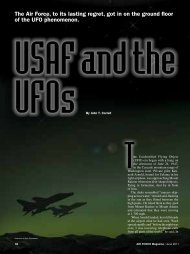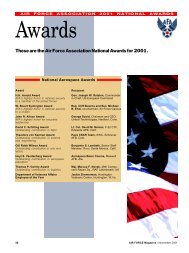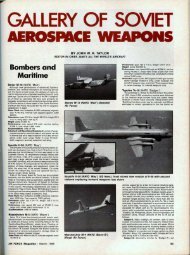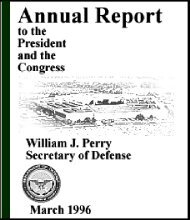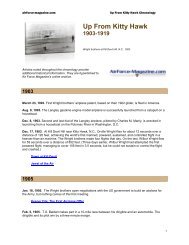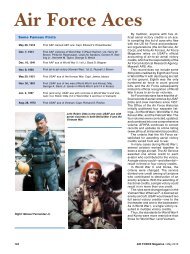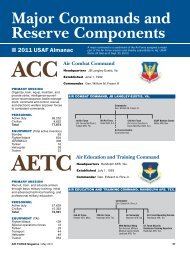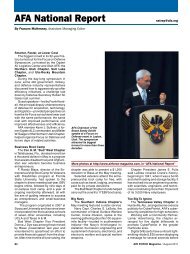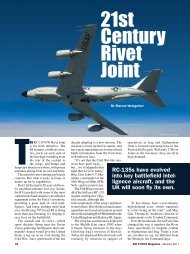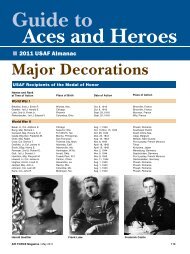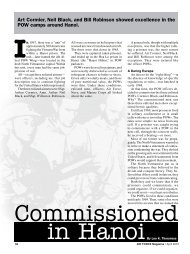1997 Annual Defense Report Table of Contents - Air Force Magazine
1997 Annual Defense Report Table of Contents - Air Force Magazine
1997 Annual Defense Report Table of Contents - Air Force Magazine
Create successful ePaper yourself
Turn your PDF publications into a flip-book with our unique Google optimized e-Paper software.
• Port call and other force visits.<br />
• Security assistance activities.<br />
• Prepositioning <strong>of</strong> military equipment and supplies.<br />
• Foreign military interactions.<br />
• <strong>Defense</strong> attaches.<br />
Stationing and deploying U.S. military forces overseas in peacetime remain essential elements <strong>of</strong> the<br />
United States' National Security Strategy and National Military Strategy. The U.S. military's peacetime<br />
overseas presence is the single most visible demonstration <strong>of</strong> America's commitment to defend U.S. and<br />
allied interests in key regions throughout the world. The presence <strong>of</strong> U.S. forces helps shape the<br />
international security environment by helping deter adventurism and coercion by potentially hostile states,<br />
reassuring friends, furthering influence and access, enhancing regional stability, and underwriting the<br />
larger strategy <strong>of</strong> engagement and enlargement. It thus strengthens the U.S. role in the affairs <strong>of</strong> key<br />
regions, such as Europe, East Asia, the Middle East, and Latin America and the Caribbean.<br />
Maintaining a sufficient level <strong>of</strong> U.S. military forces in Europe is essential to preserving U.S. influence<br />
and leadership. The reassurance that a visible and capable U.S. military presence provides both to<br />
America's traditional allies in Western Europe and to its new Partners for Peace in the East aids in the<br />
development <strong>of</strong> a stable and democratic post-Cold War Europe. This Administration will ensure that the<br />
level <strong>of</strong> U.S. military presence is sufficient to respond to plausible crises, provide tangible evidence <strong>of</strong><br />
America's commitment to preserving regional stability, and actively participate in multinational training,<br />
to minimize the likelihood <strong>of</strong> having to deploy additional forces from the continental United States in the<br />
early stages <strong>of</strong> a regional crisis. Such a force will also anchor both NATO's deterrent capability and the<br />
Alliance's ability to respond to out-<strong>of</strong>-area contingencies.<br />
In the East Asian-Pacific region, the United States is in an unparalleled position to be a stabilizing force<br />
in the multipolar regional balance that has followed the Cold War. Because the United States is a<br />
powerful but distant state, its forward deployed forces are viewed by regional actors as a reassuring<br />
presence. Any significant diminution <strong>of</strong> the U.S. military presence in the East Asia-Pacific, absent a<br />
corresponding reduction in potential threats there, would risk creating the perception <strong>of</strong> a regional power<br />
vacuum. This, in turn, could touch <strong>of</strong>f a regional arms race, threatening vital U.S. economic, political, and<br />
security interests.<br />
Most U.S. forces in the East Asian-Pacific region are forward-stationed in Japan and Korea. These<br />
include an Army division consisting <strong>of</strong> two brigades and a fighter wing-equivalent <strong>of</strong> United States <strong>Air</strong><br />
<strong>Force</strong> (USAF) combat aircraft on the Korean Peninsula; an Army Theater Area Command and Special<br />
<strong>Force</strong>s battalion, a Marine Expeditionary <strong>Force</strong>, an aircraft carrier battle group, an amphibious ready<br />
group, and one and a quarter fighter wing-equivalents <strong>of</strong> USAF combat aircraft in Japan. This force<br />
visibly demonstrates the U.S. commitment to the region, deters aggression by potentially hostile states,<br />
and allows for rapid and decisive U.S. action should deterrence fail.<br />
In the Middle East and Southwest Asia, the Administration has undertaken a strategy <strong>of</strong> dual containment<br />
<strong>of</strong> Iraq and Iran for as long as these states pose a threat to U.S. interests, other states in the region, and to<br />
their own citizens. Since Operation Desert Storm, the United States has undertaken several specific steps<br />
to enhance its military presence in the region. Some <strong>of</strong> these steps include the continuous presence <strong>of</strong> an<br />
Army heavy battalion task force in Kuwait and a Patriot air defense artillery task force in Kuwait and<br />
Saudi Arabia; prepositioning a heavy brigade set <strong>of</strong> equipment in Kuwait and a heavy battalion task force<br />
in Qatar; prepositioning a heavy brigade set afloat on ships in the Indian and Pacific Oceans; deployment<br />
<strong>of</strong> land-based aircraft in the Gulf region for Operation Southern Watch; increased naval presence<br />
19


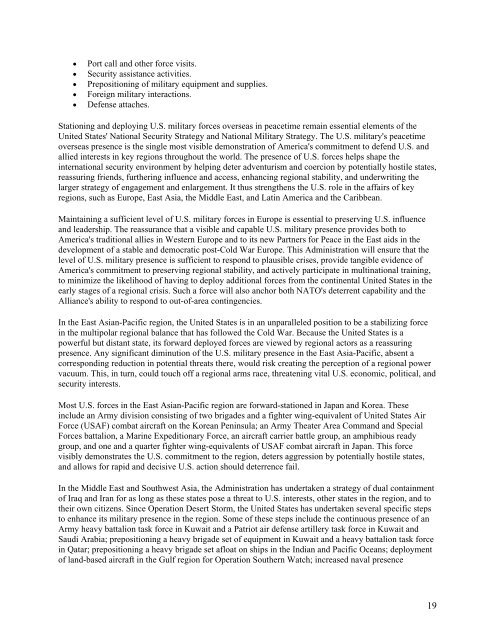
![[PDF] Foulois - Air Force Magazine](https://img.yumpu.com/13391007/1/190x253/pdf-foulois-air-force-magazine.jpg?quality=85)
